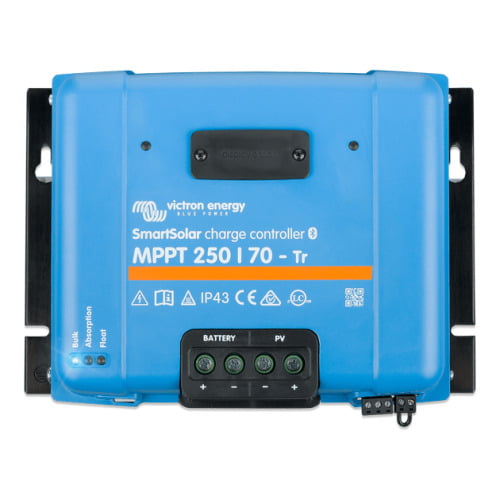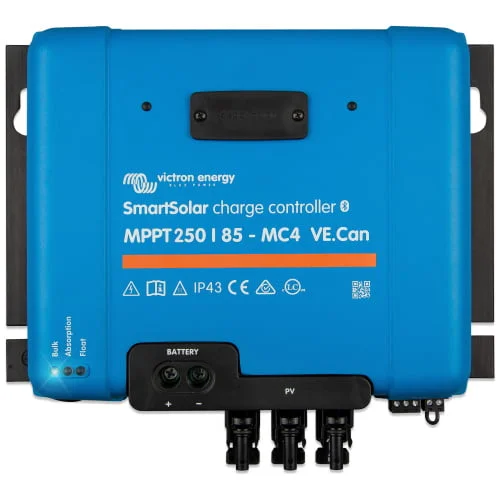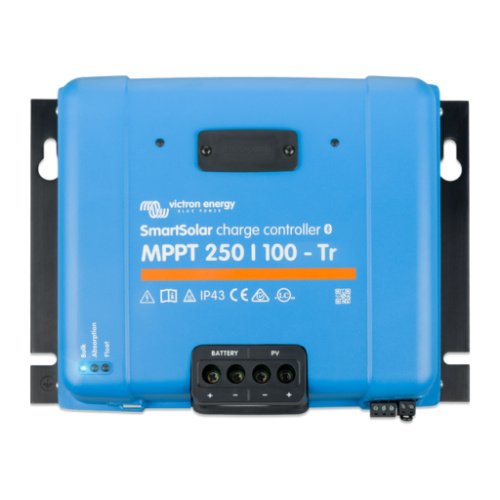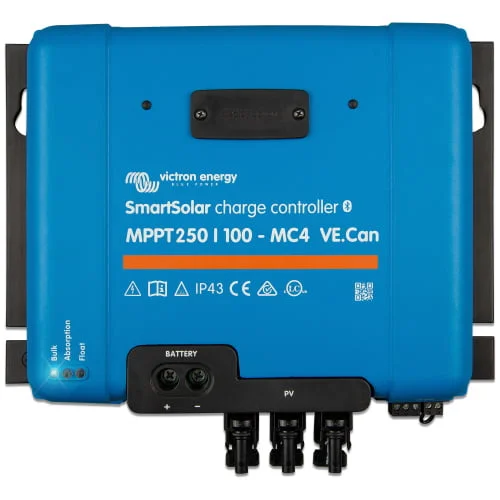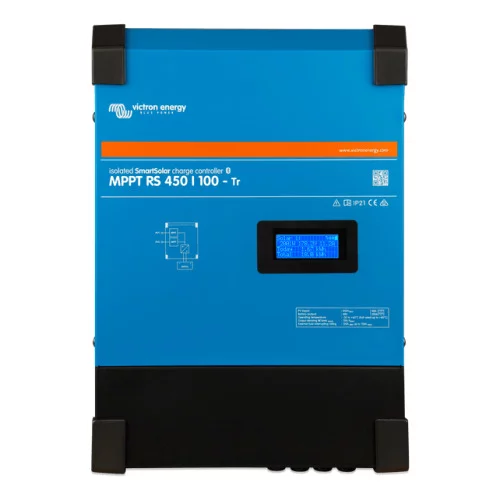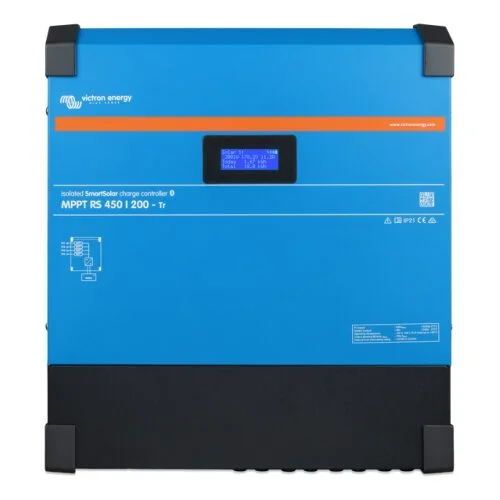- Free shipping to mainland Spain for orders over 300€.
MPPT Charge Controllers
mppt solar controller
A MPPT solar charge controller is an electrical adapter that optimises the charge, whatever the load connected to the generator. A victron mppt controller is the one that brings the most value to the installation, as it is able to measure the temperature, irradiance and electrical resistance of the circuit and thus find the optimum charging point. A victron mppt controller analyses the point of maximum power and registers it based on the detection of increases and decreases in the voltage of the solar panels.
The MPPT controller is an important part of off-grid PV systems. But if it is a grid-connected photovoltaic system, it is not so common to incorporate an MPPT 100/30, or any other model. Installations with self-consumption inverters do not incorporate these devices; because the loads are adapted to each other, so there is no benefit in incorporating an MPPT regulator.
Ultimately, a victron mppt 100/30, or any other amperage will be necessary when not working with photovoltaic modules and non-adapted voltages. The MPPT solar charge controller is placed between the output of the solar panels and the rest of the system acting as a load.
There is a wide variety of charge controllers and therefore it is essential to know the needs of the electrical installation and technical characteristics to choose the solar mppt that best suits your needs; a common model is the victron mppt 75/15.
mppt regulator: Characteristics
If you are wondering what mppt stands for, it stands for Maximum Power Point Tracking, or very fast maximum power point tracking, especially in cloudy weather and when the light intensity changes continuously. An mppt solar charge controller improves energy harvesting by up to 30% compared to PWM charge controllers.
These victron charge controllers detect the maximum power point in an advanced way, there can be two or more maximum power points on the charge voltage curve. A conventional mppt solar charge controller usually selects a local MPPT, but this is not the optimum. The maximisation of energy harvesting is achieved by the internal algorithm that selects the optimal MPPT.
Exceptional conversion efficiency of the charge controller or MPPT charge controller, it has a maximum efficiency of 98% with no fan and full output current up to 40ºC (104ºF). The charging algorithm is flexible and fully programmable.
mppt have extensive electronic protection, overheating protection and power reduction in case of high temperature. In photovoltaic panels short-circuit and reverse polarity protection as well as reverse current protection of the solar panels.
It has an internal temperature sensor that compensates the absorption and buoyancy charge voltage according to temperature.
mppt smart solar charge controllers allow real-time data to be displayed on tablets, smartphones and other Apple and Android devices.
MPPT charge regulators are high performance solar charge regulators, whose main feature is to obtain the maximum possible power at all levels of solar radiation. They are also regulators specialised in making a grid-connected solar panel work perfectly in an off-grid installation.
MPPT solar charge controllers are the devices in an installation that control and regulate the amount of energy flowing between the battery and the photovoltaic panels that make up the solar panel. The MPPT regulators include a DC-DC transformer (transforms the high-voltage direct current into a low-voltage direct current) and a controller. It allows the modules to be operated at the voltage that best suits them at any given moment, without a fixed maximum. With this mppt charge regulator, we ensure that we extract the maximum power or, on the contrary, limit it in certain phases of charging and discharging the battery.
This type of victron mppt is the most suitable and effective for high power installations, as it ensures maximum performance is extracted. In addition, it is compatible with more panels, offering greater possibilities when it comes to use; and allows you to add panels in series with a total voltage higher than that of the battery bank, as the voltage can be adapted.
MPPT regulators or MPPT solar charge controllers conserve batteries better and extend the life and efficiency of the batteries. The power of the MPPT regulator is up to 80 A.
In FVComponentes.com we have the best charge controllers on the market, the Victron brand. On our website you can find: mppt 75/15, mppt inverter, victron mppt 100/30 and many more models.
If you have any questions please contact us, at FVComponentes.com we have the cheapest MPPT controllers on the market. Getting a cheap charge controller is very simple. Contact our technicians and they will advise you on the MPPT solar controller or MPPT controller that best suits your needs.
Connecting an MPPT charge controller to a solar panel
MPPT regulators, as their name suggests, make the panel work at its maximum power point. They separate the voltage in the panels from the voltage in the batteries and are therefore a little more expensive, but they are also more efficient and make use of all possible production. For this reason, the following conditions must be taken into account:
The voltage range specified by the manufacturer:
For battery systems, a 12v battery charge regulator usually has a maximum of between 100 and 250V. This gives us greater flexibility and will allow us to work at higher voltages, which is what will prevent some power losses.
This voltage figure should not be exceeded, in very cold ambient conditions, the voltage delivered by a panel may rise slightly and the regulator manufacturer limits us with the open circuit voltage (Voc). This is the panel output figure you should pay attention to, which is higher than the voltage at maximum power (Vmp).
If we use solar panels that deliver 45.7 Voc, if we put 2 panels in series (91.4V) it is very close to the limit of a 100V mppt solar regulator. In this case we recommend using 60 cell panels which have a lower voltage (around 37 Voc) or a regulator that supports 150V.
The ideal is to always work at the highest possible voltage on the panels. For this reason it is advisable to choose the distribution of panels that allows the highest voltage without endangering the mppt victron regulator. A higher voltage will allow us a smaller section of wiring and also less problems with the distance between the solar panels and the regulator.
Maximum load current supported by the regulator:
It is the current that goes from the regulator to the battery, it is not the same as the current that goes from the panels to the regulator. In this case, if the MPPT can work with 12, 24 or 48V battery, like the mppt 24v solar charge regulator, we must divide the total power in panels by the battery voltage to know if we have chosen the right regulator.
For example, an installation of 3 x 325W panels gives a total of 975W.
- If the installation runs at 48V: 975W / 48V = 20.31A. In this case a victron 100/20, 20A regulator will suffice.
- If the installation is 24V: 975W / 48V = 40.62A. The charging current doubles, so we need an MPPT of 40A or more.
- If it is a 12V installation: 975W / 12V = 81.25A. In this case we need an 80A regulator.
A system with a higher voltage will be much more economical, as the mppt victron can be of lower current intensity and will be more efficient.
The series having identical characteristics:
When creating groups of panels connected in series-parallel pairs, all panels must be identical and carry the same number of units in each series. In order to charge the battery, we must reach a minimum voltage that is always higher than the maximum voltage that the battery will need to be fully charged in all its stages.
In an installation with mppt inverter and 60 cell panels delivering about 37Voc and with a regulator whose limit is 150Voc we can do the following:
- 2 solar panels - Single array distribution (total Voc: 74) - Suitable for 12 and 24V battery.
- 3 solar panels - Distribution in a single series (total Voc: 111) - Suitable for 12, 24 and 48V battery.
- 4 photovoltaic panels - Distribution of 2 series of 2 units (total Voc: 74) - For 12 and 24V battery.
- 5 solar panels - This distribution is not possible.
- 6 solar panels - Distribution in 2 series of 3 units (total Voc: 111) - Suitable for 12, 24 and 48V.
- 7 solar panels - Impossible distribution.
- 8 solar panels - Distribution in 4 series of 2 units (total voc: 74) - For 12 and 24V battery.
It is concluded that with a 150Voc regulator, we will make a maximum series of 3 units and then as many parallels as the power of the mppt charge regulator limits us.
In grid-connected inverters, the integrated MPPT can accept voltage ranges from 150V to 800V depending on the model, so in this case we can make long series of more than 20 solar panels, they are quite different from the mppt victron regulator.
An MPPT regulator gives us more efficiency and more flexibility when connecting any type of solar panel to our installation. We must never exceed its voltage and respect the fairness of all the branches that we are going to do in parallel. Also, if we install more solar power than the MPPT regulator is able to pass to battery charging, it will limit its output, it will not break as it happens with PWM regulators. The problem is that in times of abundant production, this extra power will be wasted.
We advise you to take into account that a solar mppt can be connected to any type of panels, but they have to be in sufficient number for a correct distribution and you have to take into account the voltage at which the batteries work.
How to calculate mppt solar controller
The mppt can be used with all types of solar panels, but it should be noted that these solar regulators were manufactured to be configured with 60-cell solar panels, as this type of panel works at different voltages than 12V and 24V panels.
A quick way to calculate the MPPT solar controller is to divide the power of the solar panels by the battery voltage.
For example, if we have a total of 1,320W of solar panels and a 24V battery: 1,320W / 24V = 55A; we can use a 50A MPPT solar regulator as these charge regulators do not burn out if the charge current is exceeded. MPPTs adjust the working voltage of the solar panels to limit the charging current.
It is important to note that the battery charging current is not the same as the solar generator current. The solar panel current depends on the series parallel configuration of the solar panels, while the charging current is calculated as above. The solar generator should never exceed the maximum allowed DC voltage at the input of the MPPT solar controller, if this occurs, the mppt will burn out. So the open-circuit voltage Voc of the solar panels and how temperature affects the output voltage of a solar panel must be taken into account to make a good calculation.
Regulatory uses mppt
The most common uses of an MPPT regulator are:
- In installations with 60-cell solar panels, because we are obliged to install MPPT regulator if we want to reach the battery charge to 100%. This type of solar charge regulator must be installed in installations where the module is grid connected and the battery bank is 12V.
- It is very useful in installations with high energy demand, as mppt is a maximising regulator that always works at its maximum power curve.
- Widely used in installations where there is a large distance between the solar modules and the battery bank. A series of solar panels are installed to gain voltage, avoid voltage losses and reduce the cable cross-section. The higher the voltage, the smaller the cable cross-section required and the less voltage losses occur.
- It is also very common in installations with limited space available for the solar panels, in order to make the most of each installed module, such as in installations for caravans and boats.
FVComponentes.com is at your disposal to answer any questions you may have about mppt or any other product on our website.

